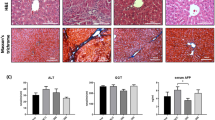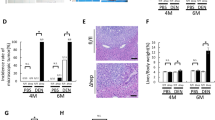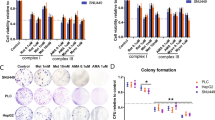Abstract
Rotenone decreases the incidence of hepatocellular carcinoma and lowers rates of hepatocellular proliferation. In an effort to delineate mechanisms involved, the in vivo effect of rotenone on liver mitochondrial metabolism, apoptotic machinery as well as elements of the hepatic signal transduction pathways were investigated. Mitochondria from livers of male B6C3F1 mice fed a standard diet containing 600 ppm rotenone for 7 days were uncoupled or inhibited when succinate or glutamate plus malate were used as the substrate, respectively. These livers also showed a significant increase in apoptosis compared with control livers. Furthermore, rotenone increased the expression of c-myc mRNA to 5-fold of control values within 3 days, an effect which was still observed (3-fold) after 7 days. Levels of p53 mRNA were also increased 3-fold after 1 day, but declined to control levels by 7 days. Rotenone also caused a transient, yet marked increase in liver particulate glyceraldehyde phosphate dehydrogenase (GAPDH) protein expression, while it did not alter the expression of the cytosolic form of the enzyme. Conversely, mRNA of the proto-oncogene H-ras showed a decline of 35% after 3 days of rotenone treatment, and remained diminished for the duration of the experiment. These data suggest that rotenone may act as an anticancer agent by diminishing mitochondrial bioenergetics which prevents basal hepatocyte proliferation and lowers the threshold for liver cells with DNA damage to undergo apoptosis.
Similar content being viewed by others
References
Cunningham ML, Soliman MS, Badr MZ, Matthews HB: Rotenone, an anticarcinogen, inhibits cellular proliferation but not peroxisome proliferation in mouse liver. Cancer Lett 95: 93–97, 1995
Isenberg J, Kolaja K, Ayoubi S, Watkins III J, Klaunig J: Inhibition of WY-14, 643 induced hepatic lesion growth in mice by rotenone. Carcinogenesis 18: 1511–1519, 1997
Oberg K: Site of action of rotenone in the respiration chain. Exp Cell Res 24:163–164, 1961
Arora K, Pedersen P: Functional significance of mitochondrial bound hexokinase in tumor cell metabolism: evidence for preferential phosphorylation of glucose by intramitochondrially generated ATP. J Biol Chem 263: 17422–17428, 1988
Rogers AE, Zeisel SH, Groopman J: Diet and carcinogenesis. Carcinogenesis 14: 2205–2217, 1993
Ellis R, Yuan J, Horvitz HR: Mechanisms and functions of cell death. Annu Rev Cell Biol 7: 663–689, 1991
Wolvetang E, Johnson K, Krauer K, Ralph S, Linnane A: Mitochondrial respiratory chain inhibitors induce apoptosis. FEBS Lett 339: 40–44, 1994
Parsons D, Williams G, Chance B: Characteristics of isolated and purified preparations of the outer and inner membranes of mitochondria. Ann NY Acad Sci 137: 643–666, 1966
Chance B, Williams G: Respiratory enzymes in oxidative phosphorylation. J Biol Chem 217: 383–393, 1955
Heruth DP, Wetmore LA, Leyva A, Rothberg PG: The influence of protein tyrosine phosphorylation on the expression of c-myc oncogene in cancer of the large bowel. J Cell Biochem 58: 83–94, 1995
Rothberg PG, Erisman MD, Diehl RE, Rovigatti UG, Astrin SM: Structure and expression of the oncogene c-myc in fresh tumor material from patients with hematopoitic malignancies. Mol Cell Biol 4: 1096–1103, 1984
Matlashewski G, Lamb P, Pim D, Peacock J, Crawford L, Benchimol S: Isolation and characterization of a human p53 cDNA clone: Expression of the human p53 gene. EMBO J 3: 3257–3262, 1984
Miesfeld R, Arnheim N: Identification of the in vivo and in vitro origin of transcription in human rDNA. Nucleic Acid Res 10: 3933–3949, 1982
Tabin CJ, Bradly SM, Bargman CI, Weinberg RA, Papageorge AG, Scolnick EM, Dhar R, Lowry DR, Chang EH: Mechanism of a human oncogene. Nature 300: 143–148, 1982
Smith PK, Krohn RI, Hermanson GT, Mallia AK, Gartner FH: Measurement of protein using bicinchoninic acid. Anal Biochem 150: 76–85, 1985
Grasl-Kraupp B, Bursch W, Ruttkay-Nedecky B, Wagner A, Lauer B, Schulte-Hermann R: Food restriction eliminates preneoplastic cells through apoptosis and antagonizes carcinogenesis in rat liver. Proc Natl Acad Sci (USA) 91: 9995–9999, 1994
Yarbrough J, Cunningham M, Yamanaka H, Thurman R, Badr M: Carbohydrate and oxygen metabolism during hepatocellular proliferation: a study in perfused livers from mirex-treated rats. Hepatology 13: 1229–1234, 1991
Nagino M, Tanaka M, Nishikimi M, Nimura Y, Kubata H, Kanai M, Kato T, Ozawa T: Stimulated rat liver mitochondrial biogenesis after partial hepatectomy. Cancer Res 49: 4913–4918, 1989
Ernester L, Dallner C, Azzone G: Differential effects of rotenone and amytal on mitochondrial electron and energy transfer. J Biol Chem 238: 1124–1131, 1963
Bereznowski Z: Effect of methyl methacrylate on mitochondrial function and structure. Int J Biochem 26: 1119–1127, 1994
Winberg L, Badr M: Mechanism of phthalate-induced inhibition hepatic mitochondrial β-oxidation. Toxicol Lett 76: 63–69, 1995
Barham S, Brinkley B: Action of rotenone and related respiratory inhibitors on mammalian cell division. 2. Ultrastructural studies. Cytobios 15: 97–109, 1976
Eguchi Y, Shimizu S, Tsujimoto Y: Intracellular ATP levels determine cell death fate by apoptosis or necrosis. Cancer Res 57: 1835–1840, 1977
Shimamatsu K, Wanless IR: Role of ischemia in causing apoptosis, atrophy and nodular hyperplasis in human liver. Hepatology 26: 343–350, 1997
Saunders P, Chalecka-Franaszek E, Chuang D-M: Subcellular distribution of glyceraldehyde-3-phosphate dehydrogenase in cerebellar granule cells undergoing cytosine Arabinoside-induced apoptosis. J Neurochem 69: 1820–1828, 1997
Huitorel P, Pantaloni D: Bundling of microtubules by GAPDH and its modulation by ATP. Eur J Biochem 150: 265–269, 1985
Gelfand V: Microtubule dynamics: mechanism, regulation and function. Annu Rev Cell Biol 7: 93–116, 1991
Hermeking H, Eick D: Mediation of c-myc induced apoptosis by p53. Science 265: 2091–2093, 1994
Kohlhuber F, Hermeking H, Graessmann A, Eick D: Induction of apoptosis by the c-myc helix-loop-helix/leucine zipper domain in mouse 3T3-L1 fibroblasts. J Biol Chem 270: 28797–28805, 1995
Morgan S, Kastan M: p53 and ATM. In: G. Woude, G. Klein (eds). Cell cycle, Cell Death, and Cancer. Adv Cancer Res. Academic Press, San Diego, vol. 71, 1997, pp 1–25
Stanley LA: Molecular aspects of chemical carcinogenesis: The roles of oncogenes and tumour suppressor genes. Toxicology 96: 173–194, 1995
Depinho RA, Schreiber-Argus N, Alt FW: MYC family oncogenes in the development of normal and neoplastic cells. Adv Cancer Res 57: 1–46, 1991
Rothberg PG, Heruth DP: Adventures in MYC-ology. Adv in Genome Biol 3B: 337–414, 1995
Horikawa S, Skata K, Hatanaka M, Tsukadato K: Expression of c-myc oncogene in rat liver by a dietary manipulation. Biochem Biophys Res Commun 140: 574–580, 1986
Mead JE, Braun L, Martin DA, Fausto N: Induction of replicative competence ('Priming') in normal liver. Cancer Res 50: 7023–7030, 1990
Saito Y, Ogawa K: Wild type p53 and c-myc co-operation in generating apoptosis of a rat hepatocellular carcinoma cell line (FAA-HTC1). Oncogene 11: 1013–1018, 1995
Goyette M, Petropoulos CG, Shank PR, Fausto N: Expression of a cellular oncogenes during liver regeneration. Science 219: 510–512, 1983
Crawford J: The liver and the biliary tract. In: R. Cotran, V. Kumar, T. Collins (eds). Robbins Pathologic Basis of Disease, sixth edition. W.B. Saunders Company, Philadelphia, 1998, pp 845–901
Author information
Authors and Affiliations
Rights and permissions
About this article
Cite this article
Wang, C., Youssef, J., Saran, B. et al. Diminished energy metabolism and enhanced apoptosis in livers of B6C3F1 mice treated with the antihepatocarcinogen rotenone. Mol Cell Biochem 201, 25–32 (1999). https://doi.org/10.1023/A:1007024905046
Issue Date:
DOI: https://doi.org/10.1023/A:1007024905046




